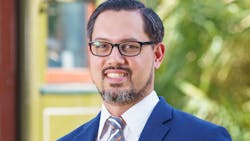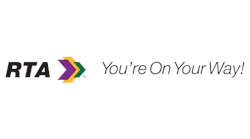- One word to describe yourself: Attentive
- Alma Mater: University of Virginia
- Fun fact about yourself: I have driven cut-away buses, 35- and 40-foot transit buses, coaches and school buses in service, and hope I can operate a 60-foot articulated bus someday.
- Favorite station or stop that you have ever visited or frequent: The pair of Tri-Met MAX light-rail stops at Pioneer Courthouse Square in Portland, Oregon. As a college intern, I was sent on a trip to study the MAX and Portland Streetcar systems and I immediately fell in love with this urban plaza, full of energy and surrounded by street-running light-rail service.
- Favorite route you have ever ridden or frequent: The historic St. Charles Avenue streetcar line in New Orleans is a local and national treasure.
For 12 years out of his 20-year career, Mike Smith simultaneously served in senior management and consulting roles and part-time operator positions, wanting to keep his skills sharp and maximize his time in the field. This has built a uniquely comprehensive resume representing key operations and safety roles for mid-size and large transit agencies, complemented further by experience as both a contractor supporting FTA's safety and oversight office and a staffer at APTA in Washington, D.C.
Currently the chief safety officer at New Orleans RTA, Smith started in transit as a sophomore at the University of Virginia and got a part-time job as a bus operator for the University Transit Service (UTS), a small, fixed-route bus system directly operated by the university. Within one year, he was promoted to trainer, and shortly thereafter, to safety supervisor. By the time he graduated in 2005 with a bachelor’s degree in urban planning, he had successfully trained four classes of bus operators, and restructured many of UTS’ safety policies and procedures, including reformatting and elevating its in-house, labor-management safety committee and combining accident review processes with operator performance appraisals.
In his current role at RTA, he is part of a completely redesigned transit agency that brought direct management of the operation in-house and provides valuable expertise to the leadership team in regulatory compliance, Safety Management Systems, accident investigation, safety audits, emergency management and project management. In 12 months, he successfully repaired a strained relationship with the state safety oversight agency; revamped the internal safety committee structure, which had been dormant; completely rewrote and successfully adopted RTA's FTA-compliant Agency Safety Plan; revamped the employee safety reporting program; streamlined accident investigation and internal safety audit procedures; and rebuilt a comprehensive safety training program including hazard identification and Roadway Worker Protection training.
Now, he continues his work to rebuild the agency's safety culture, including personally delivering an "SMS 101" training course to frontline employees that he developed based on FTA guidance and industry best practices. When he took over the position in January 2020, the agency was two years behind in its internal safety audit program, required by both the state and FTA. With an in-house team, he trained department heads on the regulatory requirements, developed checklists, gained the approval of the checklists and approach from the State Safety Oversight, conducted more than three weeks of audit activities in the field and delivered full audit reports for each topic, totaling eight. The audit function was formerly contracted out to consultants, but his team was successful in bringing it in house, which not only resulted in cost savings but also improved cross-departmental buy-in and understanding of safety program requirements and joint ownership of the corrective actions which came from the audits.
During the COVID-19 pandemic, his leadership was instrumental in establishing a formal plan. He oversaw numerous layered mitigations, coordinated with the labor union, city of New Orleans and other stakeholders, and provided technical guidance and resources to team members as needed throughout the emergency. He and his team applied for and were recently awarded two grants that will deliver safety improvements in the field. He is the first staff member at RTA to be certified under FTA's Public Transportation Safety Certification Training Program for rail. He also holds the U.S. Department of Transportation’s Safety & Security Program certificates in bus and rail transit.
When not at work, he volunteers his time in the transportation planning process in Virginia, previously serving as an appointed member of a Metropolitan Planning Organization advisory committee, and as vice chair of a bicycle/pedestrian advocacy group. He is in the process of earning certification as an Authorized Volunteer for Operation Lifesaver, Inc., and he participates in APTA's bus and rail safety committees, as well as its Rail Operating Practices Standards Working Group.
Is there a specific experience that led you to where you are today?
I remember taking a field trip as an elementary school student in Northern Virginia, to the Smithsonian National Zoo in Washington, D.C., via WMATA’s Metrorail. Looking back now, I have to laugh a little because it isn’t the exotic animals or the time spent with my classmates that I remember most vividly today—rather, it is my experience as a young Metro customer that really left an impression. I remember taking interest in the finest details such as the gentle rocking of the car’s suspension system while customers shuffled onboard at each station. It was this curiosity about trains, especially passenger trains, that ultimately led me to pursuing a career in transit.
What do you enjoy most about your job?
Throughout my career, I have had the privilege of working closely with some of the most passionate, knowledgeable, and hard-working people in the industry. I have found that dedicated public servants who want transit to be successful are out there working for all types of systems in all capacities, and they are almost always willing and eager to lend a helping hand. Whether they are in a similar role as mine or support another function, I always enjoy learning something new from my peers.
What’s the most challenging part of your job?
In order for me to be successful in my individual role, to some extent, the entire agency needs to continue to evolve, culturally, in terms of how we think about and manage safety. It can be daunting to know that the elements of our so-called “safety culture” that need the most work are often the most deeply-engrained and complicated. Take typical bus collision investigation practices, for example; I think it is fair to say that ours at RTA are fairly consistent with the industry's as a whole. The investigation often leans too heavily on the actions of the individual bus operator and is too focused on which party was "at fault" or which rules were “broken.” These actions and behaviors are usually in plain sight and so we naturally place an emphasis on them, sometimes at the cost of ignoring other contributing factors at play. Worse, this tunnel-vision is unfortunately reinforced in just about every subsequent step we take to "process" the event—from issuing discipline based on the identified rulebook violation or violations to arranging for mandatory re-training. Especially when we have been handling this type of routine issue this way for so long, the collective efforts it would take to get everyone to take a "time out" and re-think the approach can be difficult to comprehend, let alone tackle.
Accomplishment you’re most proud of and why?
I feel fortunate that I’ve had the opportunity to be successful while performing a variety of roles in the industry. One accomplishment that I am especially proud of is rewriting and adopting our agency’s FTA-compliant and State Safety Oversight-approved Public Transportation Agency Safety Plan (PTASP) last year. I feel that it was a defining achievement because beyond the fact that it technically did what the federal regulations required it to do, it laid the foundation for developing and maintaining a viable Safety Management System (SMS) at the RTA. Thanks to the efforts of my dedicated team and the continued support of the full staff, I am optimistic that we will see our SMS continue to mature and, along with it, our safety culture flourish.
Best advice/tip/best practice to share from your area of expertise?
Take full advantage of the many external networking and professional development opportunities that are out there, hosted/managed by APTA and other associations, FTA, the Transportation Research Board, and state and regional transit associations, among others. Especially in the area of transit safety, these networking platforms and events have been invaluable.




